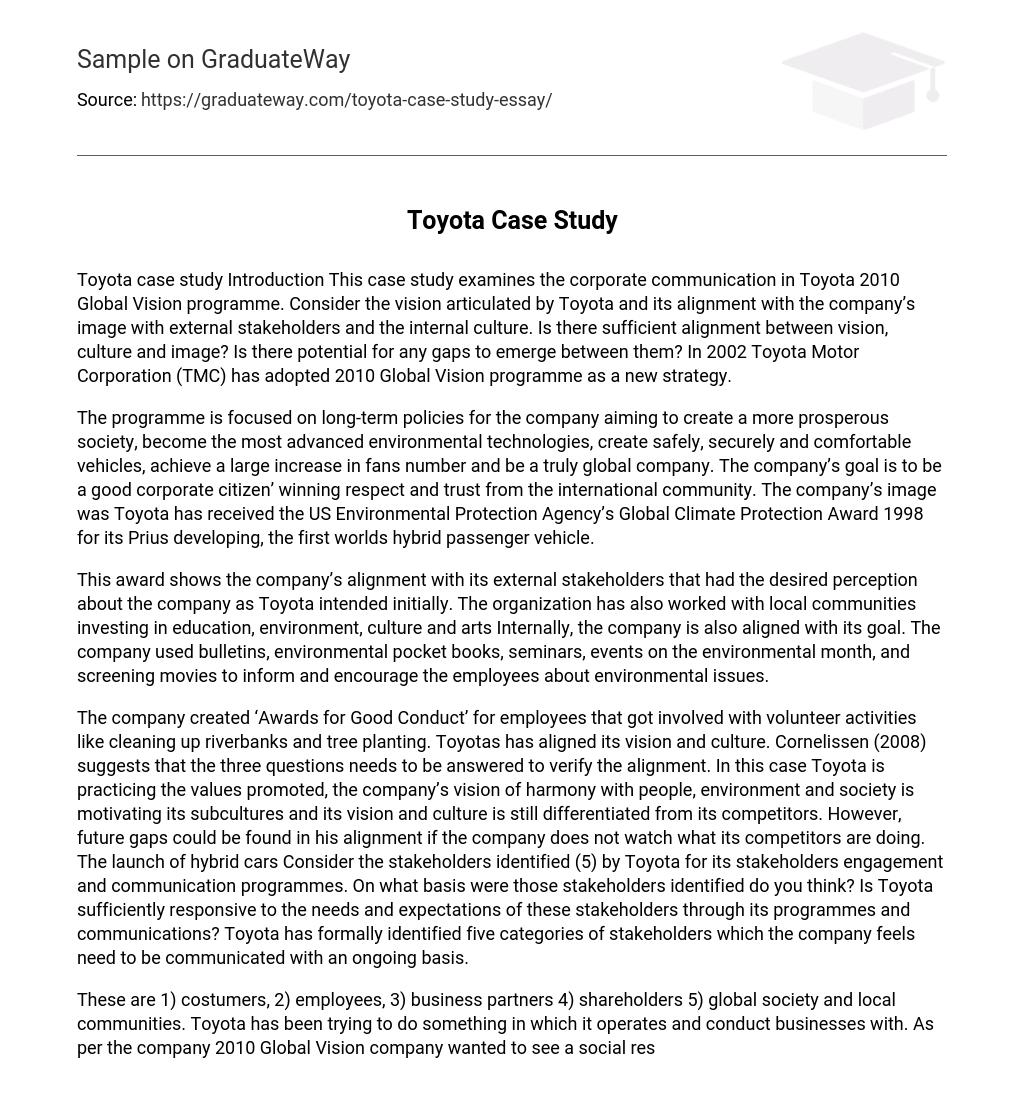Toyota case study Introduction This case study examines the corporate communication in Toyota 2010 Global Vision programme. Consider the vision articulated by Toyota and its alignment with the company’s image with external stakeholders and the internal culture. Is there sufficient alignment between vision, culture and image? Is there potential for any gaps to emerge between them? In 2002 Toyota Motor Corporation (TMC) has adopted 2010 Global Vision programme as a new strategy.
The programme is focused on long-term policies for the company aiming to create a more prosperous society, become the most advanced environmental technologies, create safely, securely and comfortable vehicles, achieve a large increase in fans number and be a truly global company. The company’s goal is to be a good corporate citizen’ winning respect and trust from the international community. The company’s image was Toyota has received the US Environmental Protection Agency’s Global Climate Protection Award 1998 for its Prius developing, the first worlds hybrid passenger vehicle.
This award shows the company’s alignment with its external stakeholders that had the desired perception about the company as Toyota intended initially. The organization has also worked with local communities investing in education, environment, culture and arts Internally, the company is also aligned with its goal. The company used bulletins, environmental pocket books, seminars, events on the environmental month, and screening movies to inform and encourage the employees about environmental issues.
The company created ‘Awards for Good Conduct’ for employees that got involved with volunteer activities like cleaning up riverbanks and tree planting. Toyotas has aligned its vision and culture. Cornelissen (2008) suggests that the three questions needs to be answered to verify the alignment. In this case Toyota is practicing the values promoted, the company’s vision of harmony with people, environment and society is motivating its subcultures and its vision and culture is still differentiated from its competitors. However, future gaps could be found in his alignment if the company does not watch what its competitors are doing. The launch of hybrid cars Consider the stakeholders identified (5) by Toyota for its stakeholders engagement and communication programmes. On what basis were those stakeholders identified do you think? Is Toyota sufficiently responsive to the needs and expectations of these stakeholders through its programmes and communications? Toyota has formally identified five categories of stakeholders which the company feels need to be communicated with an ongoing basis.
These are 1) costumers, 2) employees, 3) business partners 4) shareholders 5) global society and local communities. Toyota has been trying to do something in which it operates and conduct businesses with. As per the company 2010 Global Vision company wanted to see a social responsible company and innovative for safer and environmental friendly vehicles, Company had identified these stakeholders very consciously by using management principles and analyses of markets by doing extensive research, they joined with British Red Cross to raise awareness regarding road accidents amongst children.
They also ensured that there should be sufficient amount of ethnic dealers in their distribution chain. That means Toyota tried to meet expectations of stakeholders and communicated with them very wisely ongoing basis. Company had done CSR activities in local communities. E. g. : reforestation in China, supporting education in Africa, engagement of employees in CSR, preference to local employees. By looking at above examples one can say that company is responsive to the needs and expectations of these stakeholders through its programmes and communication.
Identify the themed messages and messages styles in Toyota’s communication. Do you think that these message styles were wise choices? What other message styles would have been possible? Cornelissen (2008) “corporate communication is a management function that offers a framework for the effective coordination of all internal and external communication with the overall purpose of establishing and maintaining favorable reputation with stakeholder groups upon which the organization is dependant. Corporate communication demands integrated approach to managing communication in company’s like Toyota defines themed messages are related to specific capabilities, strengths or values of an organization to achieve the strategic intent of changing or consolidating the company’s reputation. Reflect upon the organization of communication in Toyota. What vertical and horizontal structures exist to coordinate communication?
In organization of communication Cornelissen (2008) suggested the key issues for multi-divisional or multinational corporations of organizing communication are significantly different from those facing small companies. Toyota Motor Corporations (TMC) has used vertical and horizontal strategies to succeed on its aims. Communications within Toyota is geographically decentralized with its subsidiaries around the world. According to Cornelissen (2008) decentralizing actions give the opportunity to individual business units decide how best to handle communications.
Each of the subsidiaries has its own communication staff (marketing communications, product brand managers, internal communications and specialists in media and public affairs). Peter Renz, the National Manager PR and Advertising for Toyota Canada, explained that the decentralization is used as a way of thinking out of the box’. The organization also uses council meetings with representatives of different communications areas to discuss the strategic issues concerning communication and review their performance to guarantee its team integration.
Evaluate the handling of the Jesse Jackson cultural diversity incident and the strike at the plant in India from the perspective of issues and crisis management. Would you define these incidents as issues or crisis for Toyota? Cornelissen (2008) defines issue as a concern about the organization’s decision and operations; that may or may not involve a point of conflict in opinions and judgments regarding a company’s decision and operations. The cultural diversity incident occurred with the Crises is defined as an issue that requires not just decisive but also immediate action from the organization. Strike – crise Cult div – issue How would you characterize the response strategy of Toyota towards both incidents? Should the company have handled these incidents in a different way? Conclusion Cornelissen, J. (2008) Corporate Communication A Guide to Theory and Practice. 2nd ed. Sage. Oliver, S. (2007) Public Relations Strategy, 2nd ed. Kogan Page.





